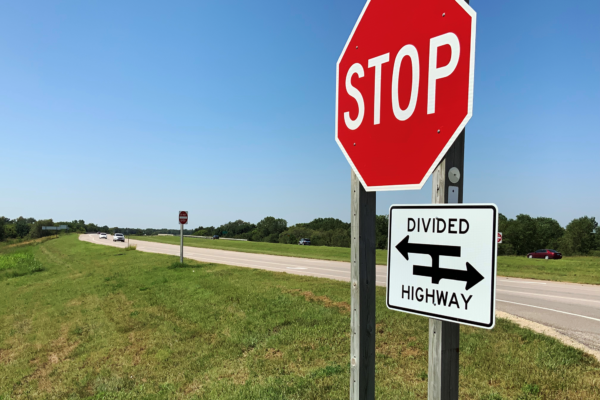An effective, integrated approach to schematic and PS&E contracts hinges on good communication
In the summer of 2023, my team was working on a large Plans Specifications and Estimate (PS&E) project delivery that crosses Interstate 45 (I-45) around Madisonville. The public hearing had been held and the environmental assessment was complete, but the schematic wasn’t environmentally cleared and the Interstate Access Justification Report (IAJR) approval was still in progress. Turns out, that was a good thing.
We’d already started work on the PS&E. Proactive and efficient, our traffic and design teams moved forward on elements for which we had a high enough degree of certainty.
We’d been working with the Texas Department of Transportation (TxDOT) and their I-45 program team on program-wide information – one element of which was the “ultimate” I-45 bridge widths. Once this criterion was established, one of our roadway engineers examined the geometric effects of these bridge widths and noticed a slight change from the schematic phase. The wider bridges resulted in an entrance and exit ramps tie-ins on I-45 (the “gore points”) changing by a couple hundred feet.
In the larger scheme of the project, this wasn’t a cataclysmic shift. But it was significant enough that the client needed to be notified of the issue for these three reasons:
- Shifting gore points could cause disruption in the IAJR approvals process with the TxDOT Design Division and FHWA
- The schematic may need to be updated to obtain environmental approval
- How and who should address the modifications needed to make the design cohesive - the schematic team or Garver's PS&E Team - had to be decided.
The client was immediately contacted for coordination between all parties involved in the project development to date, and it was decided that the schematic team would adjust their files and the IAJR to accommodate the change in bridge widths.
This might seem like a small setback, but it’s not. This is a success story. And not just in terms of its outcome for the project and our client. The success in this story is the success of an integrated, communication-focused approach to schematic and PS&E contract work, highlighting these two main points:
- Good internal and external communication is paramount.
- Implementing a "one-team" approach with an emphasis on constructability is just as critical.
Since the IAJR hadn’t yet been finalized and was still in the approvals process, this change could be made without any reevaluation. However, coordination time was limited, so through proactive communication with our client and the schematic team, a quick change was made at an optimal time, before it would have gotten more complicated, slowed the project, or increased risk.
Communication is crucial for successful navigation of the schematic and PS&E process
In projects with overlapping schematic and PS&E design phases, especially those with multiple consultants, there is always risk with concurrent work. That risk can be mitigated by the Project Manager’s (PM) understanding of where overlaps in responsibility and schedule potentially can occur, understanding of how each part of the Schematic/Environmental, Traffic, and PS&E processes are interconnected, and understanding and use of proactive external and internal communication strategies.
My previous work with TxDOT on informational materials that share strategies for achieving Ready to Let status — and best practices for managing the process — have only further reinforced the idea that tasks and milestones in schematic and PS&E contracts are not mutually exclusive and that communication strategies are crucial.
In fact, it’s communications strategies that can make points of connection out of points of overlap. Without a proactive PM championing good communication, what is a very interconnected process can become a series of disparate phases that lead to potential risk and delay. Whether you’re contracted to do just the schematic or just the PS&E, or you’re the consultant for both, proactive communication is an often-overlooked secret to keeping things running smoothly.
Proactive communication is external and internal
The client should always know what’s going on with the project, and it's important that as consultants we make sure they have that information. Best communication strategies depend on each client’s communication style. If they prefer a ten-minute phone call compared to an email message summarizing project progress, for example, make the phone call. Then, follow up and document capturing that conversation's content. If necessary, send a gentle reminder in the future if actions are still needed.
Whatever communication style your client prefers, be consistent with that communication. Each week, for example, you might send the client a short, bulleted list of what’s been accomplished, any potential risks you’ve identified, and anything in review that requires the client’s comments. Communication with TxDOT and the external schematic team, plus understanding of overlapping work, were keys to aligning with the schematic team’s designs so they could alter the IAJR in time, but not the only keys.
Internal communication is just as important as external communication, sometimes more so. While our roadway team was doing concurrent work, in parallel with work being done on the schematic side, they were also working with additional teams engaged in the traffic and design phases.
Since schematic and PS&E contract work is full of interconnections across the environmental clearing (or NEPA), traffic, and design phases, it made sense to get the respective teams in charge of delivering in these phases working together.
Task leaders are intentionally engaged for the various disciplines so that the subject matter experts responsible for leading each part of the process are empowered to do so. This forms a more versatile matrix organization, as opposed to a top-down approach. It allows our team more flexibility, facilitates communication, and encourages responsibility to each other and the project.
During milestone phases, we have the disciplines check each other’s work. When establishing a review system allowing the various disciplines to see each other’s work, you help establish a robust quality process by gathering different perspectives.
For example, people working on the environmental side collaborate with those on the traffic side, because the traffic data is the basis of a lot of their environmental Air Quality and Noise analysis. The roadway side works with traffic as well, figuring out how many lanes there should be, intersection layouts, where and how to maximize safety while improving operations and efficiency, and more.
Good communication drives effective partnerships and delivers quality transportation projects
It's tempting to think that if one consultant does both the schematic and PS&E the chances of finding issues with the earlier phases will be mitigated. And bundling the schematic/environmental and PS&E phases does streamline the overall project delivery process by consolidating the number of different entities under a single management structure.
But even then, without a thorough understanding of constructability and feasibility, issues with earlier phases can lead to extra cost and delays. The key to avoiding these is an understanding informed by experience, lessons learned, and coordination with engineering subject matter experts; a strong organizational framework; a robust quality management program; and consistent communication with the client, internal staff, and external stakeholders.
It takes partnership and know-how to deliver infrastructure projects that improve the lives of the public, and that keep our transportation systems growing and safe for future generations. Good communication is integral to getting the best from that partnership.









Share this article